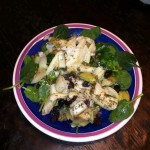LENTIL-WALNUT “MEAT” TACOS
This is a recipe I found from my new favorite food blogger, Angela Liddon. Her cookbook “Oh How She Glows” contains creative, easy to make vegan recipes. I have tried several and they are all delicious! These tacos are easy to make and absolutely delicious! The lentil and toasted walnuts create a wonderful texture for tacos, even meat eaters will be amazed! This recipe calls for lettuce wraps to make a super healthy, gluten free meal. However, feel free to experiment with flour or corn tortillas. Enjoy!
YIELD
8 LARGE TACOS (APPROX)
PREP TIME 30 MINUTES
COOK TIME 30 MINUTES
Ingredients:
FOR THE LENTIL-WALNUT MEAT (MAKES 2 1/2 CUPS):
1 cup uncooked French green lentils (you will need 1 3/4 cups cooked lentils)
1 cup walnut pieces, toasted
1 1/2 teaspoons dried oregano
1 1/2 teaspoons ground cumin
1 1/2 teaspoons chili powder
1/2 teaspoon fine grain sea salt, or to taste
1 1/2 tablespoons extra virgin olive oil
2 tablespoons water
*I used canned lentils… make sure you rinse and drain them!
FOR THE TOPPINGS/WRAPS:
1-2 bell peppers, thinly sliced (I used one, but next time I will use 2 for ample leftovers)
1/2-1 large onion, thinly sliced (I used 1/2 onion, but next time will use 1 for ample leftovers)
Cashew Sour Cream (see below)
Diced tomatoes or salsa
Green onion & fresh lime juice, for garnish
lettuce wraps (large romaine, Iceburg, or Butter lettuce leaves)
Other topping options: Sliced avocado, hot sauce, cilantro, etc.
Directions:
Cook the lentils: Rinse lentils in a fine mesh sieve. Add to a medium pot along with a few cups of water. Bring to a boil, reduce heat to medium, and simmer for 20-25 minutes until tender (cook time will vary depending on the type of lentils you use – see package). Drain off excess water.
Toast the walnuts: Preheat oven to 300F. Add walnuts onto a rimmed baking sheet and toast for 10-13 minutes, watching closely, until lightly golden and fragrant. Set aside to cool for a few minutes.
Saute the pepper + onion filling: Add 1/2-1 tablespoon of oil into a large skillet or wok. Cook the onion and peppers over medium heat for about 15-20 minutes, reducing heat if necessary and stirring frequently, until translucent.
Prepare the taco meat: Add 1 3/4 cups cooked lentils (you’ll have some leftover) and all the toasted walnuts into a food processor and pulse until chopped (make sure to leave texture). Stir or pulse in the oregano, cumin, chili powder, and salt. Stir in the oil and the water until combined.
Prepare the rest of your vegetable toppings and wash + dry the lettuce wraps.
Assemble: Add a large lettuce leaf onto a plate, top with taco meat, sauteed peppers + onion, and the rest of your desired toppings.
Leftovers can be stored in the fridge in sealed containers to be enjoyed the next couple days. The cashew cream will keep for at least a week in the fridge. Use sour cream leftovers on sandwiches, wraps, stirred into salad dressings, on vegan nachos, or with chili or soup.
Tips:
1) I used French green lentils in my taco meat because I love their chewy texture, but regular green and brown lentils work too. Do not use red lentils as they are too mushy and don’t have the required chewy texture for this recipe.
2) Nut-free taco meat: I haven’t tried this yet, but you might want to try subbing the walnuts for 1/2-3/4 cup toasted sunflower seeds. Let us know how it goes if you try it out!
3) See below for Cashew Sour Cream recipe (which really adds to these delicious tacos!)
CASHEW SOUR CREAM
Rich and tangy, this vegan sour cream makes the perfect compliment to any bowl of chili or Mexican entrée. Be sure to soak the cashews in a bowl of water for at least a couple hours (preferable overnight) before you begin.
YIELD
3/4 CUP
SOAK TIME 2-8 HOURS
PREP TIME 5 MINUTES
COOK TIME 0 MINUTES
Ingredients:
1 cup raw cashews, soaked
1/2-3/4 cup water, as needed
2 teaspoons fresh lemon juice
1 teaspoon apple cider vinegar
1/4-1/2 teaspoon fine grain sea salt, to taste
Directions:
Place cashews in a bowl and cover with water. Soak for a minimum of 2 hours, preferably overnight or for 8 hours if you have the time.
Drain and rinse the cashews and place in the blender.
Add water, lemon, vinegar, and salt. Blend on high until smooth. You might have to stop to scrape down the blender now and then or add a touch more water to get it going.
Once it’s super smooth, it’s ready! Transfer into a small container. The cream will thicken up as it sits.
VISIT www.ohhowsheglows.com for more amazing recipes by Angela Liddon





